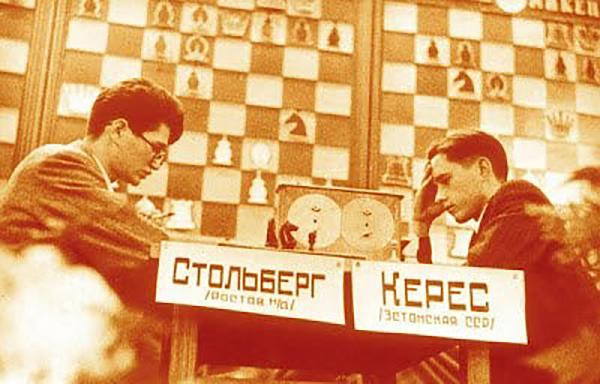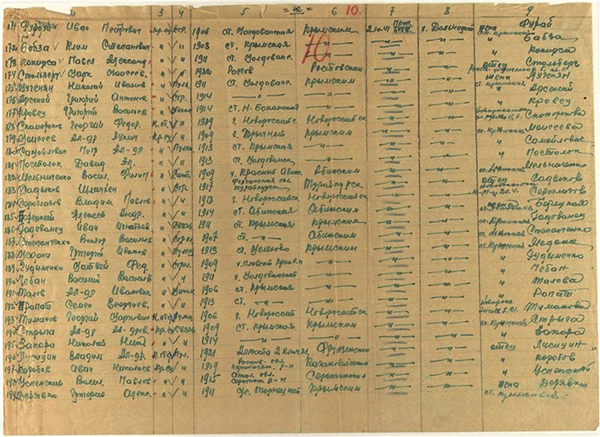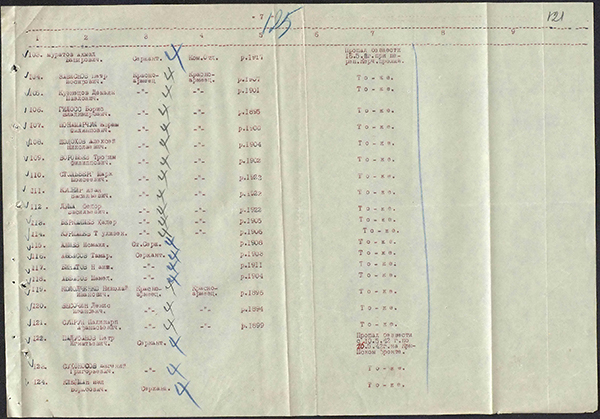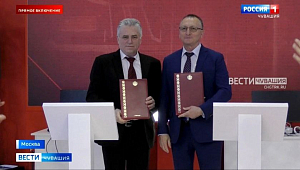2 June 2015
They did not return from the battlefield. Mark Stolberg
Grandmaster Evgeniy Solozhenkin looks into the fates of Soviet masters killed during the Great Patriotic War.
Mark Stolberg (1922–1942)
In 1939 Mark Stolberg collected 8.5 out of 13 in the all-Soviet candidate master event and took the second place. Thus the 17-year-old native of Rostov-on-Don became the youngest Soviet master.

If we consider this success as a starting point that allowed playing chess professionally, we can say that Mark's career lasted only three years. However, he had a real talent, which allowed him to go down in the Soviet chess history forever.
Mark Stolberg was talked about after the Soviet schoolboys chess tournament 1936, sensationally won by the team of Azov-Black Sea region, which surpassed both capitals. Its first board was the unknown 14-year-old first category player from Rostov-on-Don.
In two years Stolberg won the city championship among adults. He became a candidate master at the all-Soviet 1st category tournament, having shared the 1st place with the future World Champion Vasily Smyslov and the future master and famous theorist Anatoly Ufimtsev. In 1940 he had a brilliant performance in the Soviet championship semifinal, scoring 10.5/16, which was good for the joint 1st-2nd places and earned him a spot in the finals.
12th USSR Chess Championship did not go as Stolberg expected: with 8/19 he shared 13th-16th places out of 20. The event was attended by such players as Bondarevsky, Lilienthal, Keres, Boleslavsky, Smyslov, Petrov... Suffice to say that Botvinnik finished only on 5th-6th places. Everyone predicted Mark Stolberg bright chess prospects.

As the grandmaster Nikolai Shalnev states in the internet magazine "Zarubezhje" (№12, 2006), in 1940 Mark Stolberg took entrance exams to the Rostov Polytechnic Institute together with the future grandmaster Leonid Shamkovich. Shamkovich was accepted, and Stolberg didn't and soon was conscripted to the Red Army. He had bad sight, but was classified as fit for general duties with spectacles.
In June 1941 Rostov-on-Don hosted the 13th USSR Championship Semifinals; the final was scheduled for August. There were four groups containing 11 players, only two players from each group qualified for the final. Regulations: 3 hours for the first 48 moves, adjourned games continued on the next morning. Several military men were delegated to take part in the semifinal – besides Stolberg, they were S. Abramian, A. Chistiakov, and I. Rudakovsky.
D. B. Lomonosov relives certain experiences about this interrupted by the war event. Dmitry Borisovich probably was the last prisoner of war of Stalag XB Sandbostel, in which my grandfather died. In his nineties he kept actively blogging at LiveJournal. Lomonosov is a relative of the famous in USSR chess composer Evgeny Umnov. Last March he died aged 90, shortly before the 70th anniversary of Sandbostel camp liberation (29 April 2015).
Here is what Dmitry Borisovich remembered about Stolberg:
"Master Goldberg in the ordinary Red Army man uniform, boots with bindings, was probably released from the military base for the event. He always walked between the tables and seemed more interested in what was happening on the neighboring boards than on his own. On June 21, after the end of the round, I listened to the analysis of the latest game he won against the grandmaster Bondarevsky with great interest.
And the next day...
On Monday, 23 June I came to the chess club, but of course it was closed for visitors."
When I saw these recollections, I wrote Lomonosov, having told him about different fates of the semifinal participants, and got sincere gratitude for information: Dmitry Borisovich answered that he did not know anything about masters' fates. It turned out that Lomonosov did not use any search engines writing about chess, he used only his own memory! After 70 years he remembered all semifinal participants by names, only Stolberg he called "Goldberg", but actually there also was a player name Goldberg as well! Unbelievable!
All books show that Mark Stolberg died in 1943. Boris Weinstein in his book "Chess at war" (FiS, М. 1985) wrote: "The young chess player volunteered for the front on the first days. He died in 1943 on the “Minor Land”, close to Novorossijsk".
Being the NKVD colonel and head of the Soviet chess section, Weinstein for sure was a well-informed person. Still, could he also be mistaken?
Thanks to the documents found by a journalist and historian Roman Mikhailovich Nikitin in Central Archives of Ministry of Defence of the Russian Federation and The United Data bank reports we can follow the Red Army's Stolberg's tour of duty up to his death on the Kerch Strait in May 1942.
After the early finish of the Rostov semifinal Mark Stolberg returned to his military base, 157th rifle division of the North-Caucasian Front(now the famous 76th Guards Air Assault Division), located in Novorossijsk. The division entered the war in mid-September, when at the order of General Headquarters it was moved to help besieged Odessa. On September 22 the 157th division together with the 3rd Marine Regiment, the Black Sea Fleet pilots and the first formation of the Maritime Army and fighters of the 421st rifle division took part in the operation, which resulted in defeating and pushing back the 13th and the 15th Romanian divisions by 5-8 km. Stolberg's division itself left the battlefield with minimal losses.
To implement instructions of General Headquarters the forces of Odessa defensive district evacuated on the Crimean Peninsula, 157th division left Odessa one of the first at the beginning of October and was relocated to Sevastopol. It was placed under orders of the 51st Army and to the end of October was heavy fighting for Perekop. Then followed relocation back in Novorossijsk and the Battle of the Kerch Peninsula.
The United Data bank has a document saying that Mark Moiseevich Stolberg, a rifleman of the 157th division, born in 1922, a native of Rostov, on 2 October 1941 went missing close to the Dalnitsky village, Ovidiopol Raion, Odessa region.

By the way, according to various documents of The United Data bank (and with different mistakes in the last name spelling) my grandfather's brother "went missing", "died" and even "was taken prisoner" In fact he was badly wounded, returned home and after the war died a natural death in 70s.
Mark Stolberg didn't go missing on 2 October 1941 near Dalnitsky. But thanks to this document we got to know that master Stolberg took part in the heaviest battle prior to the evacuation on the Crimea:
"The command of Odessa defensive district decided to draw the forces of 157th division for counterattack in the South sector. 25th division was reinforced by 141st tank squadron, 384th rifle division and 422nd separated artillery division.
On 2 October in the morning after the volley of the 48th separate battalion of the Guards mortars (Katyusha) and the 20-minute artillery barrage, which was attended by armored train "Za Rodinu" ("For the Motherland"), 42nd and 40th separated artillery divisions, and 422nd howitzer artillery regiment, and 384th rifle regiment switched to the attack. Our foot attacked the first rank cut line and was almost unopposed. Suppressed by fire rocket launchers on the right flank, the Romanian foot disorderly started to retreat.
By 11 o'clock front units of the 384th rifle regiment went out on the southern slopes of the Dalnitsky. The opponent hastily started to pull in troops. Two foot squadrons by vehicles reached the subdivisions of neighboring 54th rifle regiment. The movement of vehicles in the hollow was taped by the artillery forward observers of lieutenant I.A. Pakholiuk from 422nd howitzer artillery regiment. Having received the aim coordinates, a division of capitan A.M. Meerson inflicted fire damage from all 12 howitzers.
The 3rd squadron of the 384 rifle regiment tried to occupy a high point to the south of hamlet Dalnitsky, but is didn't work. Machine guns, which artillery observers could not detect and suppress in terrain folds, prevented it. While automatic rifleman attacked the height from the front, the commander of machine-gun, staff sergeant Savchenko and Red Army man Turin waded from the flank, using the terrain folds. Unexpected fire of our gun deflected attention of defenders. This halt was used by sergeant Dubnev's rifle squad, which stepped off together with neighboring squads. When the bullet struck the commander, he was replaced by Red Army men Arzamasov, who was first to break into the trench. The surviving Romanians fled, throwing four working guns with plenty of bullets.
Approaching Dalnitsky, the 384th regiment defeated two squadrons of the 5th Romanian border regiment, but turned to defense, counterattacked by the 1st Border Division, supported by tanks and artillery mortar fire. Romanians planned the main battle at the intersection of the advanced 2nd regiment battalion and a few stragglers combat formations of cavalry division. Approximately 200 enemy soldiers in armored personnel carriers wedged on the left wing of the regiment. Several armored vehicles were destroyed by our artillery, but dismounted gunners continued to move deeper into our defenses, trying to get out of the corn fields to the front of 2nd battalion. The platoon of automatic riflemen attacked the battery observing station of lieutenant V.S. Skubak from the 422nd howitzer artillery regiment. Three intelligence officer and two communicators headed by the battery commander let a hostile chain closer, then threw grenades and opened fire with rifles. Eight automatic riflemen fell down dead, others hit the deck. Fighting off grenades and covering each other by fire from rifles, artillery lossless moved to alternate vantage point, where lieutenant Skubak continued to control fire power.
About 80 Romanians seeped into our rear area and came to the command post of the captain A.M. Meyerson's howitzer battalion. Cutting off the escape routes of the enemy machine gun and carbines, the commander of the division called for the battery fire, which scattered the enemy with a few volleys. Gunners were sitting in trenches and the fire of our howitzers didn't harm them. At the suggestion of the executive officer of the 384th rifle regiment, squadron leader A.T. Kijashko, anti-aircraft regiment moved with its four-on anti-aircraft guns mounted on vehicles in regiment battle formations. Using the terrain folds, abound with hollows and unharvested corn, anti-aircraft, maneuvering on the battlefield, suddenly appeared and opened murderous dagger fire.
The tankmen of the 141st independent reconnaissance battalion fought heroically. Shooting enemy soldiers and crushing their tracks, 15 BT-7 tanks broke west to Lenintal the positions of enemy mortar and artillery batteries. A part was destroyed, and the rest, taken in tow, were dragged to its location as trophies.
When darkness fell, the Romanians tried to circumvent the position of the regiment, but the anti-aircraft machine-gun company pulled out of the reserve by the regiment of lieutenant M.P. Zavalniuk attacke and captured a hundred of Romanians. The 2nd advanced battalion was surrounded and only on the third day returned back.
After defeating the four battalions of the Romanians and thoroughly mauling the 1st Romanian border division, in the afternoon on the order of the maritime army commander the division stopped the attack.
Our military units have caused significant damage to the enemy and captured 44 guns, more than 40 machine guns, several mortar batteries, a lot of rifles and machine guns. 160 Romanian soldiers and officers were captured. It is noteworthy that the prisoners were escorted at the port by two women from the local destructive battalion.
The 384th rifle division also suffered bad losses. In its rifle regiments about one third of the personnel fell out.
The battle for hamlet Dalnitsky was the last one for the division near Odessa".
After that Mark Stolberg was redeployed to the 136th army reserved rifle division. There is nothing unusual in this fact, because according to the Regulations on reserved units of ground forces during the wartime an acquisition of reserved military units personnel performed including evacuees from the front. It could be that in a fight on October 2 Stolberg was wounded, and this might be the reason for the relocation to the reserve.
In January 1942 Stolberg is located in the village Abinskaya, Krasnodar region. In May the regiment was ordered to come forward to the Crimean peninsula. Roman Nikitin writes:
“Stolberg is not presented in the alphabetic list – here we see mainly Armenian last names. It is so to speak the national-territorial rifle division. Russian or Ukrainian last names are rare, and no Jewish ones. It is surprising that in the book of orders for 1942 Armenian surnames almost never occur. Although here are indicated mainly the commanders and officers, reports on ordinary forces are much lesser. But I was lucky to find Stolberg in one of them!“
Central Archives of Ministry of Defence of the Russian Federation, f.36 azsp, о.288657, d.1, l.185
ORDER № 17
to the 136th army reserved rifle division
17 January 1942 Encampment Abinskaya
Paragraph 11
Red Army men listed below should be redeployed in the 3rd squadron.
.....
9. Stolberg M.M.
.....
Occasion: The artillery division captain's report from 12.01.1942.
At the beginning of May the regiment was relocated to Taman. Then followed only a bankside through the Kerch Strait and back, which became fatal.
Central Archives of Ministry of Defence of the Russian Federation, f.136 azsp, о.288657, d.1, l. 255 ob.
ORDER № 125
to the 136th army reserved rifle division
5 May 1942, st. Taman
Due to the fact of regiment relocation on an order № 40 of the Crimean front command staff, 3 echelons started moving to the new garrison from Novorossisk lager on 2, 3 and 4 May.
Regimental headquarters is considered to arrive at the station Taman.
“Actually, I have only one question. How Mark Stolberg and a group of military men tried to cross the strait? Obviously he couldn't swim down the strait himself (people who attempted that were gone with the flow). So it was a self made floatation device (for example, a float made of inflatable bladders), or a small boat, both of which had no chances to reach the Taman Peninsula. Most likely there were to embarkation rosters here. Hundreds and thousands of frightened people often jammed for the opportunity to get on any boat".
Here I can add only a quote from Vsevolod Abramov's book "Kerch catastrophe 1942" (M.: Jausa, Eksmo 2006), devoted to these events:
Acoording to the irrecoverable losses report, the master Mark Moiseevich Stolberg went missing during the bankside of Red Army parts through the Kerch Strait on 16 May 1942:

Relatives got the letter with this information:

Sources:
B. Weinstein «Chess battles» (FiS, М. 1985)
"The bet is more than the life" (Sergey Voronkov's article on chesspro.ru)
The United Data bank "Memorial"






















